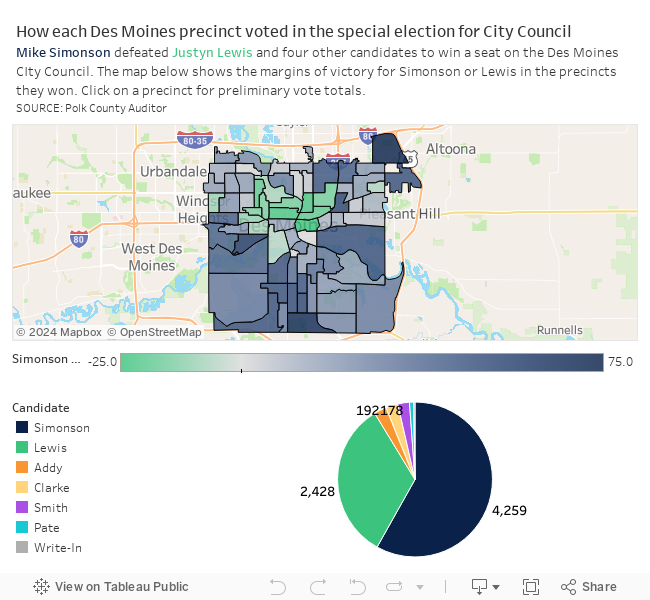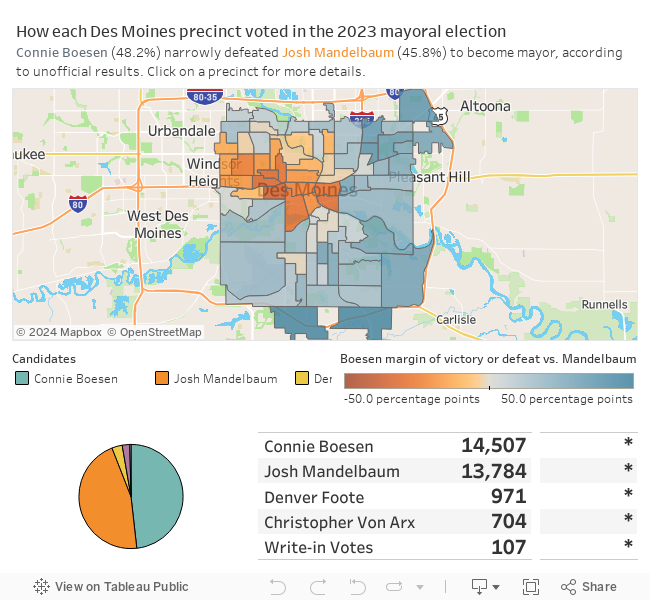How did Mike Simonson win the Des Moines council at-large seat? We break down the votes:
Des Moines has a new City Council member after Mike Simonson defeated Justyn Lewis and several other candidates in Tuesday’s special election to win the right to serve the remainder of Mayor Connie Boesen’s term.
The special election lacked the drama of other recent citywide races, such as last November’s mayoral race, when less than 3 percentage points separated the top two candidates. Simonson won the seat with relative ease, earning about 58% of the preliminary vote count, according to unofficial results from the Polk County auditor.
Lewis came in second with about 33% of the vote. None of the three remaining candidates — Dr. Claudia Addy, Benjamin Clarke and Rose Marie Smith — nor Robert Pate, who had dropped out of the race before Election Day but remained on the ballot — earned more than 3% of the votes.
Precinct-by-precinct vote counts from the auditor's office show voting patterns in Des Moines for the at-large election loosely mimic those of the November mayoral race, where Boesen claimed victory over council member Josh Mandelbaum.
Here are some takeaways from the precinct-level data:
Which parts of Des Moines voted for Simonson, Lewis?
Simonson’s strongest pockets of support came from the outer portions of Des Moines, the precinct-level data shows.
Those were precincts such as precincts 1 and 24 in the northeast corner of the city, near Altoona, where 58 of 74 voters filled in Simonson’s bubble. Precincts in the southwest corner of the city, south of Grand Avenue and west of Fleur Drive, collectively voted for Simonson at a rate of about 70%, compared to 23% for Lewis.
Lewis, meanwhile, had the most success north of downtown: He won 12 precincts north of Interstate 235 and just three south of it. One of those precincts includes the East Village, where Lewis won by nearly 30 percentage points (albeit across a small population of voters).
Lewis didn’t win any other precinct by more than 25 percentage points, and that’s where Simonson pulled ahead: He kept it close in the precincts Lewis won, and racked up large shares of the votes in many other precincts.
Broken down by ward, Lewis garnered the strongest support in the southern edges of Ward 1 (northwest) and Ward 2 (northeast). Meanwhile, Simonson dominated in the other parts of wards 1 and 2, and the vast majority of Ward 3 (central and southwest) and Ward 4 (southeast).
Special election follows similar voting patterns to recent mayoral election
If the precinct-level map from Tuesday’s special election looks familiar, it may be because the election for Des Moines mayor last November showed a similar-looking spread of votes.
Boesen’s politics aren’t a one-to-one analog for Simonson, nor is Lewis a perfect match to Mandelbaum. But the two pairs drew from similar areas of support.
In the mayoral election, Boesen defeated Mandelbaum with victories in outer precincts. Like Lewis, Mandelbaum won precincts representing the downtown area and areas north of I-235. But Boesen stayed close enough in those areas for her wins in the south and east of the city to carry her to victory.
But Boesen’s win was much closer than Simonson’s — decided by fewer than a thousand votes. That’s because Simonson’s margins over Lewis were better across the city, and particularly in the downtown area.
One such location: Precinct 44 in the heart of downtown, bounded by the Des Moines and Raccoon rivers, Grand Avenue to the north and Ninth Street to the west.
Mandelbaum won this precinct by more than 20 percentage points in November, but Simonson earned 56% of the vote there Tuesday, building a margin of more than 16 percentage points.
Areas with the highest turnout favored Simonson
Turnout in November’s general election resulted in much higher vote totals than Tuesday’s one-off special election. Voters cast more than 30,000 ballots in the mayoral race; the total cast in the special election was slightly less than a quarter of that.
The distribution of votes across Des Moines, however, was remarkably similar between the two elections. And many of the areas that cast the most votes were also the areas where Simonson won big, particularly the southeast portions of the city.
The high turnout there, coupled with Simonson’s high margins of victory in that area, resulted in an insurmountable lead and a relatively easy victory for Des Moines’ newest City Council member.
Des Moines Register reporter Virginia Barreda contributed to this story.
Tim Webber is a data visualization specialist for the Register. Reach him at twebber@registermedia.com and on Twitter at @HelloTimWebber.
This article originally appeared on Des Moines Register: Des Moines' votes in at-large council race mimic 2023 mayoral election


